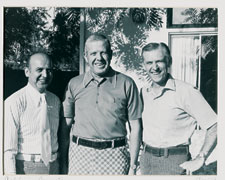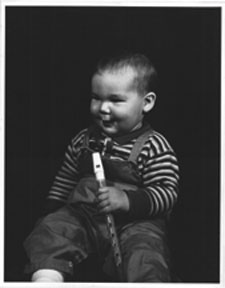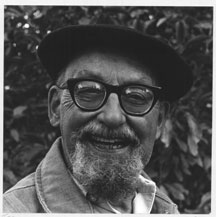| |
September 28, 2004
Photos by Paul Mielke '42 Wabash gave me the brothers that nature denied me." Wabash student, longtime class agent, mathematics professor, and educational innovator, Professor Emeritus Paul Mielke brought computer science to the College in 1962 and founded the Indiana Colleges Mathematics Competition in 1966. The Paul Mielke Fellowship Fund, established in 2003 by a grateful former student, Ted Wiese, Jr. ’60 and his wife, Sandra, pays tribute to his mentoring of generations of Wabash men.
But the skilled teacher of proofs, postulates, and theorems has an artist’s eye. Photography, his avocation, dovetailed with his extraordinary commitment to the people of Wabash to give us a visual history of the College as it evolved through the 1960s, 70s, and 80s. That collection includes photographs of students and faculty with George Wallace, Eugene McCarthy, Robert Kennedy, Allen Ginsberg, Angela Davis and other icons of the era.
Mielke’s portraits, though, best reveal his affection for friends and colleagues here.
“I come from a family of six children, but I’m the only boy in the family,” Mielke says. “Wabash gave me the brothers that nature denied me, so the brotherhood created by the College is very important to me.” Storm Rising  Vern Robinson '37 was also a Lambda Chi, but I only Vern Robinson '37 was also a Lambda Chi, but I only
learned of our common affiliation after Jack Charles brought Vern back to Wabash to teach languages. Vern and his brother owned a cabin on the Tippecanoe River at Leichters Ford. I visited him there twice each year. There I took this photograph, with the storm coming in behind him. It rained moments after I took this.
Talk about brothers . . .  Now, these are brothers—Dale Baker ’43, Tom Boyer ’43, and myself. We were roommates at the Lambda Chi house, and this was taken at Dale’s house in Los Altos, California, 30 years after our days at Wabash. It wasn’t until we joined Lambda Chi that we became ‘fraternity brothers,’ but we were brothers in spirit before then. We bonded together as persons. Now, these are brothers—Dale Baker ’43, Tom Boyer ’43, and myself. We were roommates at the Lambda Chi house, and this was taken at Dale’s house in Los Altos, California, 30 years after our days at Wabash. It wasn’t until we joined Lambda Chi that we became ‘fraternity brothers,’ but we were brothers in spirit before then. We bonded together as persons.
Much later, when our son went to Stanford University, Dale and his wife, Hazel, picked him up at the airport, housed him, and let him drive their car to appointments. For years, they were like his uncle and aunt out there.
Another generation  Mead Killion ’61 is a former student and good friend—scientist, inventor, and entrepreneur—and this is his first-born son, Thann. I took the photograph here at our home: the backdrop is a black velvet opera cape, and Mary Lou held it up behind Thann while I took the picture. Years later, my final sabbatical leave, Thann came down and helped me build a room in my house—he was a teenager, but he worked joyfully, and we built it together. Mead Killion ’61 is a former student and good friend—scientist, inventor, and entrepreneur—and this is his first-born son, Thann. I took the photograph here at our home: the backdrop is a black velvet opera cape, and Mary Lou held it up behind Thann while I took the picture. Years later, my final sabbatical leave, Thann came down and helped me build a room in my house—he was a teenager, but he worked joyfully, and we built it together.
“Energy and brightness that shines through”  Theodore Wolcott Stuart III was my homeroom teacher at William Horlick High School in Racine, Wisconsin. Ted was an iconoclast, very independent, and he sparkled; his brightness and energy shined through. He was a splendid English teacher and a wonderful person, one of those who really shaped me. Teaching, so much more than imparting knowledge, is a commitment and a relationship. Ted and I remained close friends—I think the relationship between us radiates in this photograph. Theodore Wolcott Stuart III was my homeroom teacher at William Horlick High School in Racine, Wisconsin. Ted was an iconoclast, very independent, and he sparkled; his brightness and energy shined through. He was a splendid English teacher and a wonderful person, one of those who really shaped me. Teaching, so much more than imparting knowledge, is a commitment and a relationship. Ted and I remained close friends—I think the relationship between us radiates in this photograph.
A fine musician and mind reader  David Green taught philosophy and religion here, and was a splendid pianist. He was a wonderful accompanist, and he accompanied our son, P.T., who played the bassoon. At state contest at DePauw one year, P.T. blanked out on the piece he’d memorized. David immediately suspected what had happened, picked up where P.T. was in the score, and P.T. won the contest! It was like David had read P.T.’s mind, and Mary Lou tells me that’s how he was when he played harpsichord with her in their baroque quartet. A fine musician. David Green taught philosophy and religion here, and was a splendid pianist. He was a wonderful accompanist, and he accompanied our son, P.T., who played the bassoon. At state contest at DePauw one year, P.T. blanked out on the piece he’d memorized. David immediately suspected what had happened, picked up where P.T. was in the score, and P.T. won the contest! It was like David had read P.T.’s mind, and Mary Lou tells me that’s how he was when he played harpsichord with her in their baroque quartet. A fine musician.
|